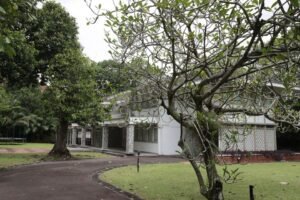The elder son of former president Ong Teng Cheong is taking his sister-in-law to court, nearly a year after settling a dispute with her husband – his younger brother – over the architectural business founded by their parents.
This time, the dispute is related to an award-winning Art Deco bungalow in Dalvey Estate near the Botanic Gardens that used to be the private residence of the late Mr Ong Teng Cheong, The Straits Times has learnt.
Court documents obtained by ST showed that Mr Ong Tze Guan brought a legal action on Aug 17 against Madam Wang Yi Yi, the wife of his younger brother, Mr Ong Tze Boon, who is executive chairman of the Ong&Ong group.
The elder Mr Ong has applied for court orders to get Madam Wang to either buy his share of the Dalvey Estate bungalow based on the prevailing market valuation, or for the property to be sold on the open market and the sales proceeds to be divided equally between him and Madam Wang.
In his application, he asked that should the property be sold in the open market, the proceeds would be applied to fees, stamp duties and expenses related to the property sale, and be divided equally between him and his sister-in-law in respect to the 50 per cent share they each hold, or in a proportion determined by the court.
According to a property title search, Mr Ong Tze Guan and Madam Wang are listed as tenants in common in equal shares in the two-storey bungalow, which is in the Dalvey Estate Good Class Bungalow (GCB) area.
Designed by Frank Wilhim Brewer (1886-1971) and built in 1927, the bungalow is one of 14 conserved buildings in the Nassim Road & White House Park Conservation Area.
In the mid-1990s, the bungalow was restored and extended by Mr Ong Teng Cheong’s architectural practice.
In response to queries, Mr Ong Tze Guan told ST he is not at liberty to comment because the matter is before the courts.
ST has contacted Mr Ong Tze Boon’s lawyer to reach Madam Wang for comment.
This latest dispute follows an earlier suit that Mr Ong Tze Guan filed in April 2021 against his younger brother and six other shareholders, alleging that the defendants had acquired his 28.45 per cent stake in Ong&Ong Holdings at an undervalue.
He had proposed selling his shares for $5.4 million, but his stake was transferred to the other shareholders for $1.65 million, based on a valuation by the company’s auditors.
The elder Mr Ong wanted the High Court to set aside the valuation and order the defendants to buy him out, either at an agreed price or at a price fixed by an independent expert.
The defendants contended that they had acted in accordance with company procedure.
Mr Ong Tze Boon, who had a 70.43 per cent stake in the company, counterclaimed against Mr Ong Tze Guan for defamation and to recover an outstanding personal loan.
In October 2021, Mr Ong Tze Guan confirmed to ST that the matter has been resolved through mediation. The terms of the settlement are confidential.
Mr Samuel Eyo, managing director of Lighthouse Property Consultants, said the last caveated GCB transaction in Dalvey Estate in May 2021 was at $50 million, or $2,494 psf for a 20,048 sq ft property.
But the former president’s conservation bungalow can potentially fetch between $3,600 and $3,800 psf, because asking prices in Dalvey Estate have jumped to close to $4,000 psf due to the area’s proximity to the Nassim Road GCB area, which has seen transacted prices hitting those levels, Mr Eyo said.
“It’s also rare for a conservation house in the Dalvey GCB area to be in private hands, because many such houses tend to be owned by the Government. And because the house is owned by architects, it is presumably in a well-kept condition,” he added.
The bungalow, which was one of the winners of the URA’s 2001 Architectural Heritage Awards, was built according to a “three bay colonial bungalow plan” with living and dining rooms at each side of the building, and a car porch and an entrance foyer in the centre on the first storey. The property includes an outhouse that houses the servants’ quarters and guest room.
The bungalow’s designer, Mr Brewer, was reportedly the first university-trained architect to practise in Singapore and was influenced by the Arts and Crafts movement.
The bungalow’s elements reflect the movement’s heavy and robust style, including oriole windows, exposed brickwork on corner buttresses and arches, as well as window openings in geometric patterns.
Source : The Straits Times




